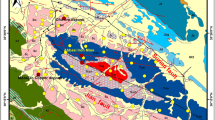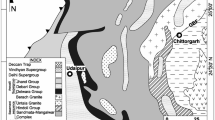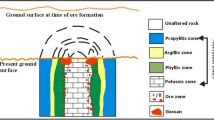Abstract
The exploration of mafic anomaly in South Pole-Aitken (SPA, the largest confirmed) basin on the Moon provides important insights into lunar interior. The landing of Chang’e-4 (CE-4) and deployment of Yutu-2 rover on the discontinuous ejecta from Finsen crater enabled in-situ measurements of the unusual mineralogy in the central portion of SPA basin with visible and near-infrared imaging spectrometer (VNIS). Here we present detailed processing procedures based on the level 2B data of CE-4 VNIS and preliminary mineralogical results at the exploration area of Yutu-2 rover. A systematic processing pipeline is developed to derive credible reflectance spectra, based on which several spectral and mineral indices are calculated to constrain the mafic mineralogy. The mafic components in the soils and boulder around CE-4 landing site are concluded as clinopyroxene-bearing with intermediate composition and probably dominated by pigeonite although the possibility of mixing orthopyroxen (OPX) and calcic clinopyroxene (CPX) also exists. These mineralogical results are more consistent with a petrogenesis that the CE-4 regolith and rock fragment are derived from rapid-cooling magmatic systems and we interpret that the materials at the CE-4 landing site ejected from Finsen crater are probably recrystallized from impact melt settings.
Similar content being viewed by others
References
Di K, Liu Z, Liu B, et al. Chang’e-4 lander localization based on multi-source data. J Remote Sens, 2019, 23: 177–184
Wu W, Li C, Zuo W, et al. Lunar farside to be explored by Chang’e-4. Nat Geosci, 2019, 12: 222–223
Liu J, Ren X, Yan W, et al. Descent trajectory reconstruction and landing site positioning of Chang’e-4 on the lunar farside. Nat Commun, 2019, 10: 4229
Garrick-Bethell I, Zuber M T. Elliptical structure of the lunar South Pole-Aitken basin. Icarus, 2009, 204: 399–408
Hurwitz D M, Kring D A. Differentiation of the South Pole-Aitken basin impact melt sheet: implications for lunar exploration. J Geophys Res Planets, 2014, 119: 1110–1133
Lucey P G, Taylor G J, Hawke B R, et al. FeO and TiO2 concentrations in the South Pole-Aitken basin: implications for mantle composition and basin formation. J Geophys Res, 1998, 103: 3701–3708
Pieters C M, Tompkins S, Head J W, et al. Mineralogy of the mafic anomaly in the South Pole-Aitken basin: implications for excavation of the lunar mantle. Geophys Res Lett, 1997, 24: 1903–1906
Moriarty Iii D P, Pieters C M. The character of South Pole-Aitken basin: patterns of surface and subsurface composition. J Geophys Res Planets, 2018, 123: 729–747
Pieters C M, Head Iii J W, Gaddis L, et al. Rock types of South Pole-Aitken basin and extent of basaltic volcanism. J Geophys Res, 2001, 106: 28001–28022
Lawrence D J, Feldman W C, Elphic R C, et al. Iron abundances on the lunar surface as measured by the lunar prospector Gamma-ray and neutron spectrometers. J Geophys Res Planets, 2002, 107: 5130
Prettyman T H, Hagerty J J, Elphic R C, et al. Elemental composition of the lunar surface: analysis of gamma ray spectroscopy data from Lunar Prospector. J Geophys Res, 2006, 111: E12007
Lawrence D J, Feldman W C, Barraclough B L, et al. Thorium abundances on the lunar surface. J Geophys Res, 2000, 105: 20307–20331
Kobayashi S, Karouji Y, Morota T, et al. Lunar farside Th distribution measured by Kaguya gamma-ray spectrometer. Earth Planet Sci Lett, 2012, 337–338: 10–16
Jolliff B L, Wieczorek M A, Shearer C K, et al. New Views of the Moon. Gottingan: Mineralogical Society of America, 2018. 60
Fu X H, Qiao L, Zhang J, et al. The subsurface structure and stratigraphy of the Chang’e-4 landing site: orbital evidence from small craters on the Von Kármán crater floor. Res Astron Astrophys, 2020, 20: 008
Gou S, Di K, Yue Z, et al. Lunar deep materials observed by Chang’e-4 rover. Earth Planet Sci Lett, 2019, 528: 115829
Huang J, Xiao Z, Flahaut J, et al. Geological characteristics of Von Kármán crater, northwestern South Pole-Aitken basin: Chang’e-4 landing site region. J Geophys Res Planets, 2018, 123: 1684–1700
Li C, Liu D, Liu B, et al. Chang’e-4 initial spectroscopic identification of lunar far-side mantle-derived materials. Nature, 2019, 569: 378–382
Ling Z, Jolliff B L, Liu C, et al. Composition, mineralogy, and chronology of mare basalts in Von Kármán crater: a candidate landing site of Chang’e-4. In: Proceedings of the 49th Lunar and Planetary Science Conference, Houston, 2018. 1939
Ling Z, Jolliff B L, Liu C, et al. A close view of Chang’e-4 landing site and science questions to be answered by Yutu-2. In: Proceedings of the 50th Lunar and Planetary Science Conference, Houston, 2019. 2330
Ling Z, Qiao L, Liu C, et al. Composition, mineralogy and chronology of mare basalts and non-mare materials in Von Kármán crater: landing site of the Chang’e-4 mission. Planet Space Sci, 2019, 179: 104741
Qiao L, Ling Z, Fu X, et al. Geological characterization of the Chang’e-4 landing area on the lunar farside. Icarus, 2019, 333: 37–51
He Z, Xu R, Li C, et al. Visible and near-infrared imaging spectrometer (VNIS) for in-situ lunar surface measurements. In: Proceedings of Sensors, Systems, and Next-Generation Satellites XIX, 2015. 9639
Liu B, Li C L, Zhang G L, et al. Data processing and preliminary results of the Chang’e-3 VIS/NIR imaging spectrometer in-situ analysis. Res Astron Astrophys, 2014, 14: 1578–1594
Gueymard C A. The Sun’s total and spectral irradiance for solar energy applications and solar radiation models. Sol Energy, 2004, 76: 423–453
Li C, Wang Z, Xu R, et al. The scientific information model of Chang’e-4 visible and near-IR imaging spectrometer (VNIS) and in-flight verification. Sensors, 2019, 19: 2806
Savitzky A, Golay M J E. Smoothing and differentiation of data by simplified least squares procedures. Anal Chem, 1964, 36: 1627–1639
Hapke B. Space weathering from Mercury to the asteroid belt. J Geophys Res, 2001, 106: 10039–10073
Pieters C M, Taylor L A, Noble S K, et al. Space weathering on airless bodies: resolving a mystery with lunar samples. Meteoritics Planet Sci, 2000, 35: 1101–1107
Clark R N, Roush T L. Reflectance spectroscopy: quantitative analysis techniques for remotesensing applications. J Geophys Res, 1984, 89: 6329–6340
Clark R N, Swayze G A, Livo K E, et al. Imaging spectroscopy: earth and planetary remote sensing with the USGS Tetracorder and expert systems. J Geophys Res, 2003, 108: 5131
McCord T B, Clark R N, Hawke B R, et al. Moon: near-infrared spectral reflectance, a first good look. J Geophys Res, 1981, 86: 10883–10892
Sunshine J M, Pieters C M, Pratt S F. Deconvolution of mineral absorption bands: an improved approach. J Geophys Res, 1990, 95: 6955–6966
Kaur P, Bhattacharya S, Chauhan P, et al. Mineralogy of Mare Serenitatis on the near side of the Moon based on Chandrayaan-1 Moon Mineralogy Mapper (M3) observations. Icarus, 2013, 222: 137–148
Wu Y, Li L, Luo X, et al. Geology, tectonism and composition of the northwest Imbrium region. Icarus, 2018, 303: 67–90
Zhang X Y, Ouyang Z Y, Zhang X M, et al. Study of the continuum removal method for the Moon Mineralogy Mapper (M3) and its application to Mare Humorum and Mare Nubium. Res Astron Astrophys, 2016, 16: 115
Besse S, Sunshine J M, Staid M I, et al. Compositional variability of the Marius Hills volcanic complex from the Moon Mineralogy Mapper (M3). J Geophys Res, 2011, 116: 13
Cheek L C, Donaldson Hanna K L, Pieters C M, et al. The distribution and purity of anorthosite across the Orientale basin: new perspectives from Moon Mineralogy Mapper data. J Geophys Res Planets, 2013, 118: 1805–1820
Horgan B H N, Cloutis E A, Mann P, et al. Near-infrared spectra of ferrous mineral mixtures and methods for their identification in planetary surface spectra. Icarus, 2014, 234: 132–154
Pelkey S M, Mustard J F, Murchie S, et al. CRISM multispectral summary products: parameterizing mineral diversity on Mars from reflectance. J Geophys Res, 2007, 112: 14
Salvatore M R, Mustard J F, Wyatt M B, et al. Definitive evidence of Hesperian basalt in Acidalia and Chryse planitiae. J Geophys Res, 2010, 115: E07005
Cloutis E A, Gaffey M J. Pyroxene spectroscopy revisited-spectral-compositional correlations and relationship to geothermometry. J Geophys Res, 1991, 96: 22809–22826
Gaffey M J, Bell J F, Brown R H, et al. Mineralogical variations within the S-type asteroid class. Icarus, 1993, 106: 573–602
Varatharajan I, Srivastava N, Murty S V S. Mineralogy of young lunar mare basalts: assessment of temporal and spatial heterogeneity using M3 data from Chandrayaan-1. Icarus, 2014, 236: 56–71
Pieters C M, Englert P A J. Remote Geochemical Analysis, Elemental and Mineralogical Composition. Cambridge: Cambridge University Press, 1993
Adams J B, Goullaud L H. Plagioclase feldspars-visible and near infrared diffuse reflectance spectra as applied to remote sensing. In: Proceedings of the 9th Lunar and Planetary Science Conference, 1978. 2901–2909
Donaldson Hanna K L, Cheek L C, Pieters C M, et al. Global assessment of pure crystalline plagioclase across the Moon and implications for the evolution of the primary crust. J Geophys Res Planets, 2014, 119: 1516–1545
Ohtake M, Matsunaga T, Haruyama J, et al. The global distribution of pure anorthosite on the Moon. Nature, 2009, 461: 236–240
Tompkins S, Pieters C M. Spectral characteristics of lunar impact melts and inferred mineralogy. Meteoritics Planet Sci, 2010, 45: 1152–1169
Adams J B, Horz F, Gibbons R V. Effects of shock-loading on the reflectance spectra of plagioclase, pyroxene, and glass. In: Proceedings of the 10th Lunar and Planetary Science Conference, 1979. 1–3
Johnson J R, Hörz F. Visible/near-infrared spectra of experimentally shocked plagioclase feldspars. J Geophys Res, 2003, 108: 5120
Crown D A, Pieters C M. Spectral properties of plagioclase and pyroxene mixtures and the interpretation of lunar soil spectra. Icarus, 1987, 72: 492–506
Klima R L, Pieters C M, Dyar M D. Spectroscopy of synthetic Mg-Fe pyroxenes I: spin-allowed and spin-forbidden crystal field bands in the visible and near-infrared. Meteoritics Planet Sci, 2007, 42: 235–253
Klima R L, Pieters C M, Dyar M D. Characterization of the 1.2 µm M1 pyroxene band: extracting cooling history from near-IR spectra of pyroxenes and pyroxene-dominated rocks. Meteoritics Planet Sci, 2008, 43: 1591–1604
Gross J, Treiman A H, Mercer C N. Lunar feldspathic meteorites: constraints on the geology of the lunar highlands, and the origin of the lunar crust. Earth Planet Sci Lett, 2014, 388: 318–328
Shearer C K, Elardo S M, Petro N E, et al. Origin of the lunar highlands Mg-suite: an integrated petrology, geochemistry, chronology, and remote sensing perspective. Am Miner, 2015, 100: 294–325
Shearer C K, Hess P C, Wieczorek M A, et al. Thermal and magmatic evolution of the Moon. Rev Mineral GeoChem, 2006, 60: 365–518
Lemelin M, Lucey P G, Gaddis L R, et al. Global map products from the Kaguya multiband imager at 512 ppd: Minerals, FeO, and OMAT. In: Proceedings of the 47th Lunar and Planetary Science Conference, 2016. 2994
Lucey P G. Mineral maps of the Moon. Geophys Res Lett, 2004, 31: L08701
Bickel C E, Warner J L, Phinney W C. Petrology of 79215-Brecciation of a lunar cumulate. In: Proceedings of Lunar and Planetary Science Conference, 1976. 7: 1793–1819
Dymek R F, Albee A L, Chodos A A. Comparative petrology of lunar cumulate rocks of possible primary origin-Dunite 72415, troctolite 76535, norite 78235, and anorthosite 62237. In: Proceedings of Lunar and Planetary Science Conference, 1975. 6: 301–341
Takeda H, Miyamoto M. Inverted pigeonites from lunar breccia 76255 and pyroxene-crystallization trends in lunar and achondritic crusts. In: Proceedings of Lunar and Planetary Science Conference, 1977. 8: 2617–2626
Warner J L, Simonds C H, Phinney W C. Apollo 17, Station 6 boulder sample 76255-Absolute petrology of breccia matrix and igneous clasts. In: Proceedings of Lunar and Planetary Science Conference, 1976. 7: 2233–2250
Nakamura Y, Kushiro I. Equilibrium relations of hypersthene, pigeonite and augite in crystallizing magmas: microprobe study of a pigeonite andesite from Weiselberg, Germany. American Mineralogist, 1970, 55: 1999–2015
Hawke B R, Blewett D T, Lucey P G, et al. The origin of lunar crater rays. Icarus, 2004, 170: 1–16
Wilhelms D E, John F, Trask N J. The Geologic History of the Moon. United States Geological Survey, 1987
Morrison D A. Did a thick South Pole-Aitken basin melt sheet differentiate to form cumulates? In: Proceedings of the 29th Lunar and Planetary Science Conference, 1998. 1657
Vaughan W M, Head J W, Wilson L, et al. Geology and petrology of enormous volumes of impact melt on the Moon: a case study of the Orientale basin impact melt sea. Icarus, 2013, 223: 749–765
Vaughan W M, Head J W. Impact melt differentiation in the South Pole-Aitken basin: Some observations and speculations. Planet Space Sci, 2014, 91: 101–106
Acknowledgements
This work was supported by National Natural Science Foundation of China (Grant Nos. 11941001, 41972322, U1931211), Natural Science Foundation of Shandong Province (Grant No. ZR2019MD008), Qilu Young Scholar (TANG SCHOLAR) Program of Shandong University, Weihai (Grant No. 2015WHWLJH14), Key Research Program of Frontier Sciences, Chinese Academy of Sciences (Grant No. QYZDY-SSW-DQC028), and Pre-research Project on Civil Aerospace Technologies Funded by China National Space Administration (CNSA) (Grant No. D020102).
Author information
Authors and Affiliations
Corresponding author
Rights and permissions
About this article
Cite this article
Chen, J., Ling, Z., Qiao, L. et al. Mineralogy of Chang’e-4 landing site: preliminary results of visible and near-infrared imaging spectrometer. Sci. China Inf. Sci. 63, 140903 (2020). https://doi.org/10.1007/s11432-019-2768-1
Received:
Revised:
Accepted:
Published:
DOI: https://doi.org/10.1007/s11432-019-2768-1




